At the beginning of the 1970s, Tamás Cseh’s songs exploded like bombs in the local pop-rock scene, which was dominated mostly by works with conventional lyrics. The explanation for this conventionality lies in the fact that access to the public and the various forums and channels of the arts (radio, television, record companies) was filtered on multiple levels, so artists were obliged to choose topics that would not upset the authorities if they actually wanted exposure. However Cseh and his lyricist Bereményi were not hoping or looking for success with the wider public at the time.
Cseh’s songs were personal in a manner that allowed an entire generation to identify with them. They were popular in part because of the literary quality of the lyrics and in part because of the emphatic, playful style of presentation. The lyrics, written by Géza Bereményi, evoked typical characters and localities of the era, catching moods and emotions often by describing anxieties and visions. These lyrics were sung by Cseh with deep empathy but also playfully. Cseh filled the verses with emotions by using simple, familiar melodies, modulating the tempo, inserting breaks, and repeating certain parts.
A decade earlier, Cseh and his friends created a community to experience what they understood as the lifestyle of Native Americans in the Bakony mountains. They were studying the life and practices of nineteenth-century American Indians. They organized war games in forest camps that they made themselves and according to rules that they invented themselves. The games lasted for a few weeks and were held once or twice a year. Although the purpose of the games was to experience courage, true-heartedness, and love of nature in a community, the authorities considered it an illegal activity and also a quasi-religious activity (as stories about Native Americans were popular in the already banned religious scout circles).
Strangely enough, his first serious encounter with the secret police occurred for different reasons as a consequence of an investigation against companions of his who intended to open a club and organize happenings. However, he was later kept under observation due to the “Native American” games and his activities as a musician. His career as a singer developed in an unusual way. Current research has revealed that initially he was motivated to sing in front of an audience by the avant-gardists Miklós Erdély and János Baksa Soós. Later, directors (like Péter Bacsó, Judit Elek, Miklós Jancsó, and Ferenc Grünwalsky) helped him gain the attention and interest of the public, and he was regularly invited to perform his songs on theatre stages.
Due to his growing popularity, Cseh was eventually able to release an album as well (seven years after his first hundred songs had been composed). It was followed by several others. In addition to his stage performances in theatres, he often gave concerts nationwide accompanied by a single guitar, and he continued the Native American role-playing games until his death. Chief Smoke in His Eye, a character of sorts played by Cseh, is fondly remembered by many.
The foundation which preserves Tamás Cseh’s legacy was planned in 2011, and in 2012 it became a legal entity. The archive (established in 2012 under the supervision of OSZK) administers and handles the documents and objects related to the oeuvre of Tamás Cseh. It collects them, digitizes them, and submits them to scientific study and organization. It also publishes them. In 2013, supervision was taken over by the National Archives of Hungary. Since 2015, the archive has functioned within the legal framework of the Hungarian Art Nonprofit Ltd.

